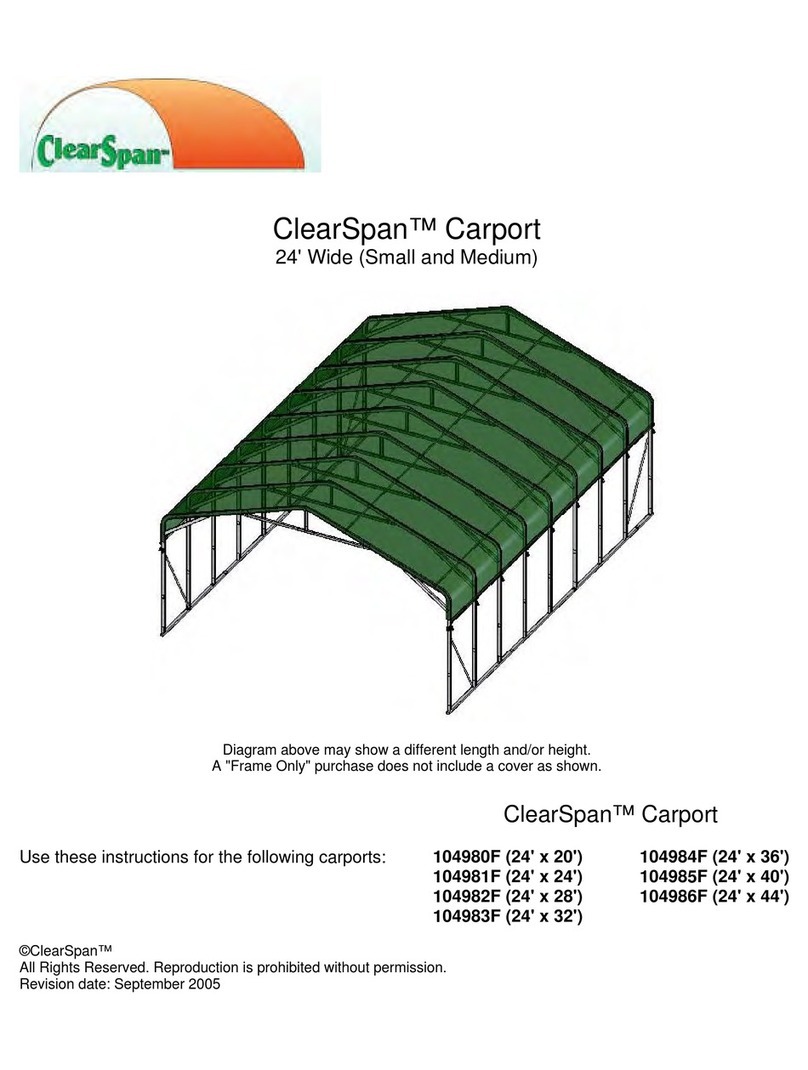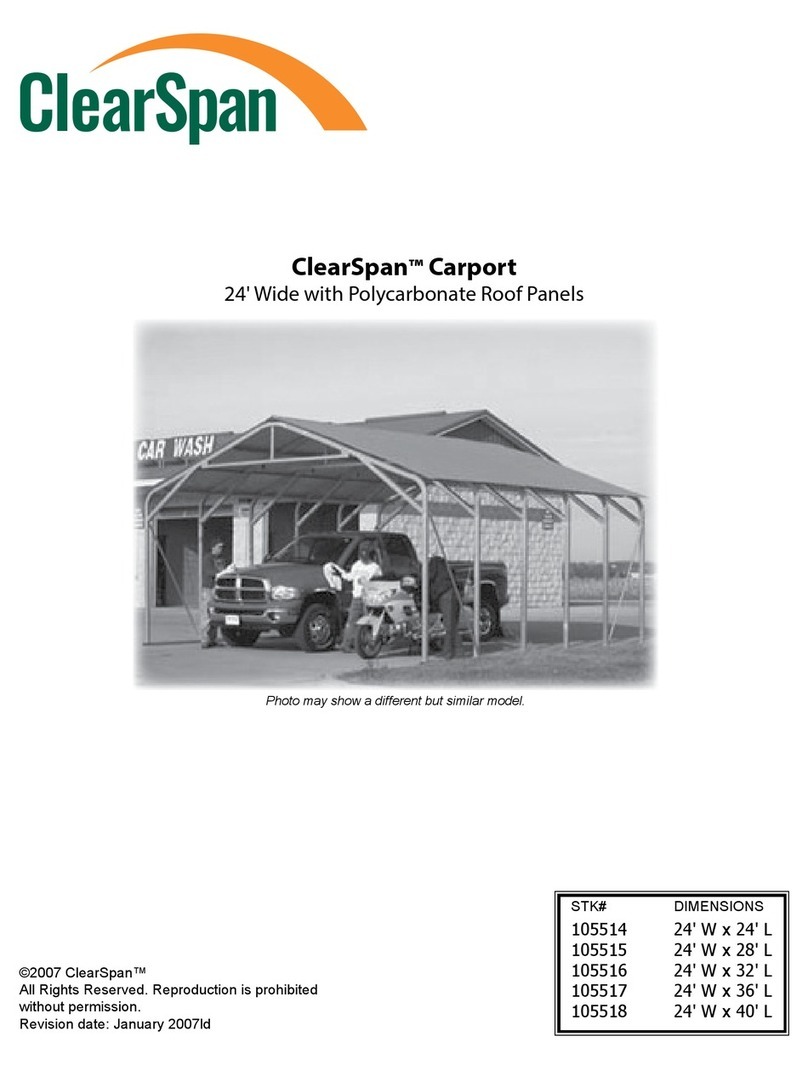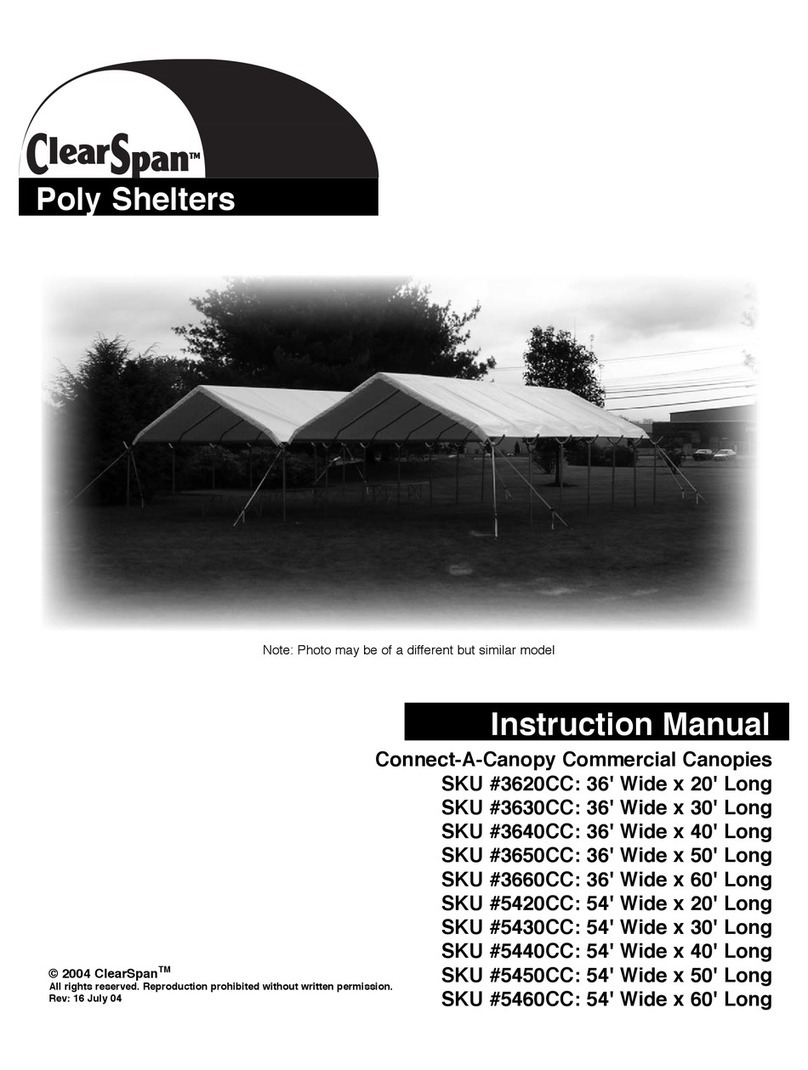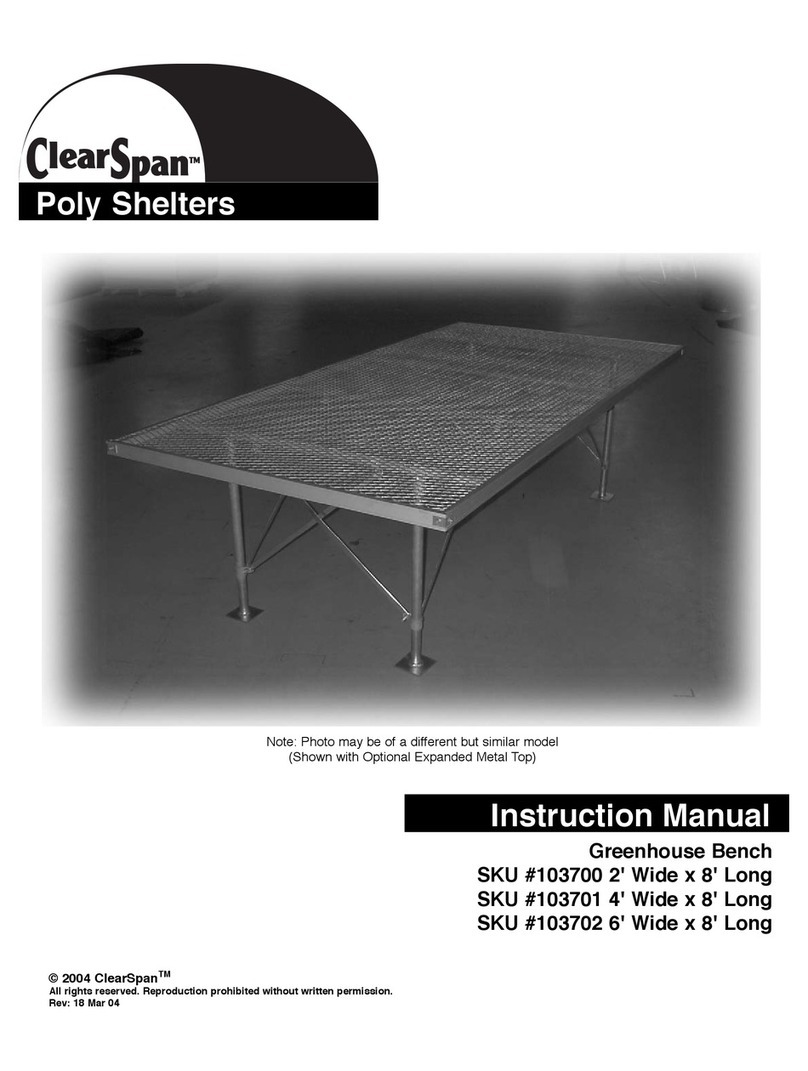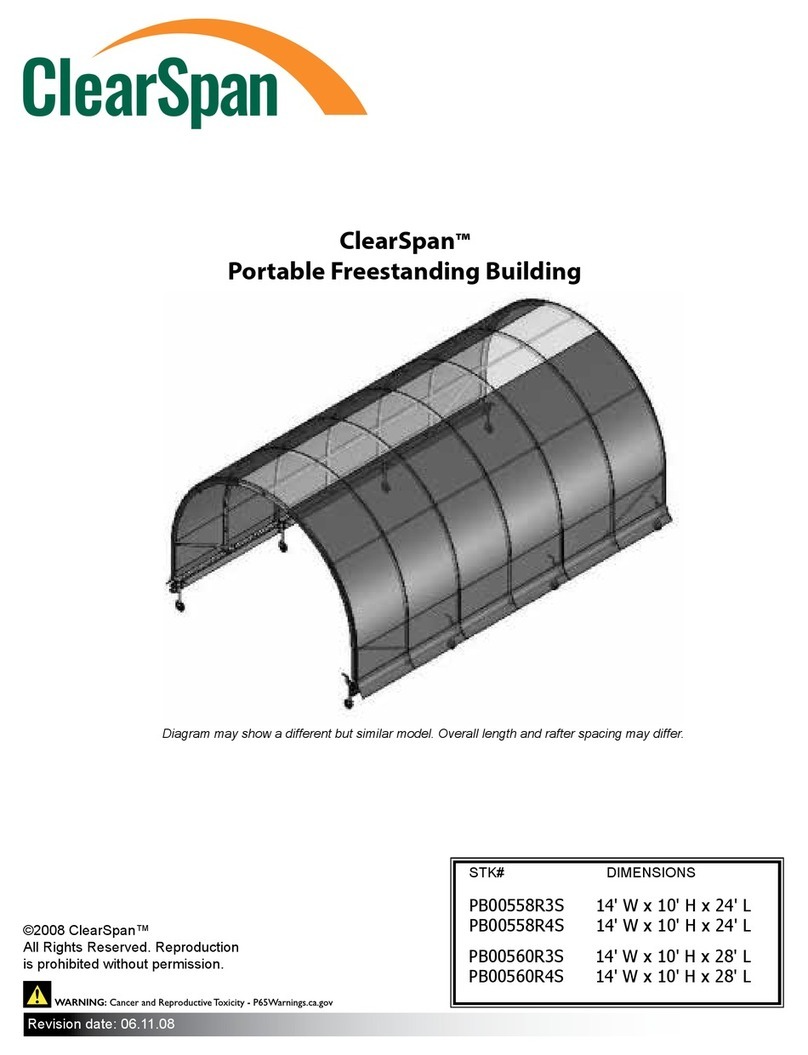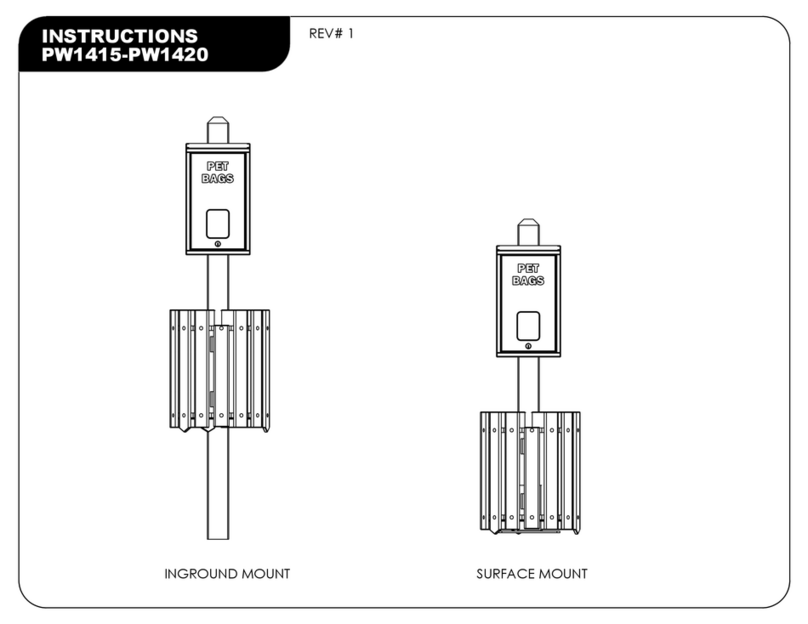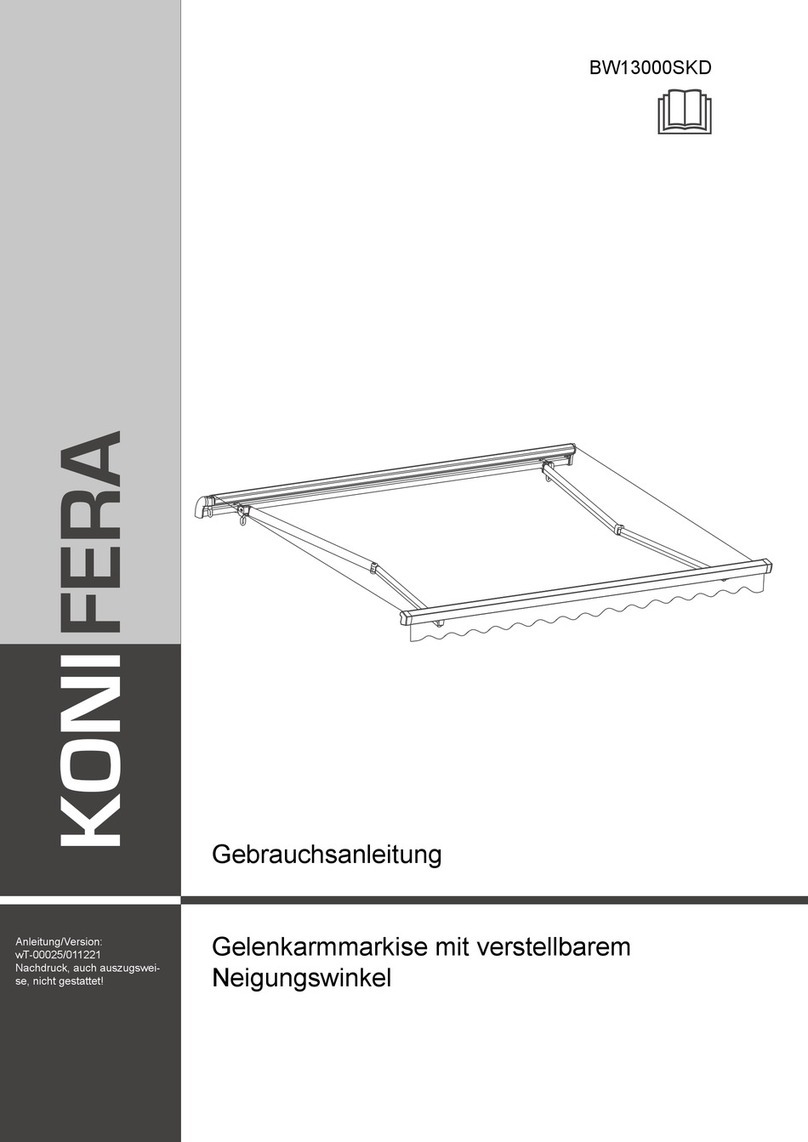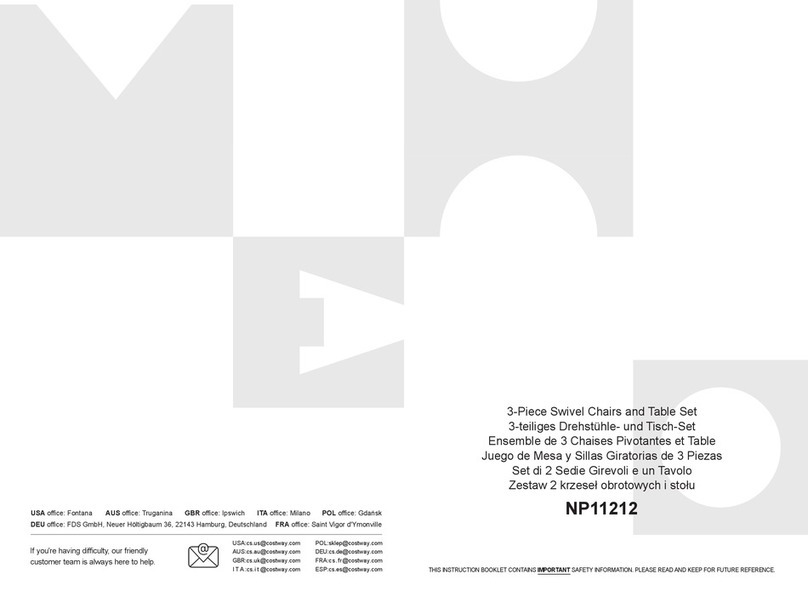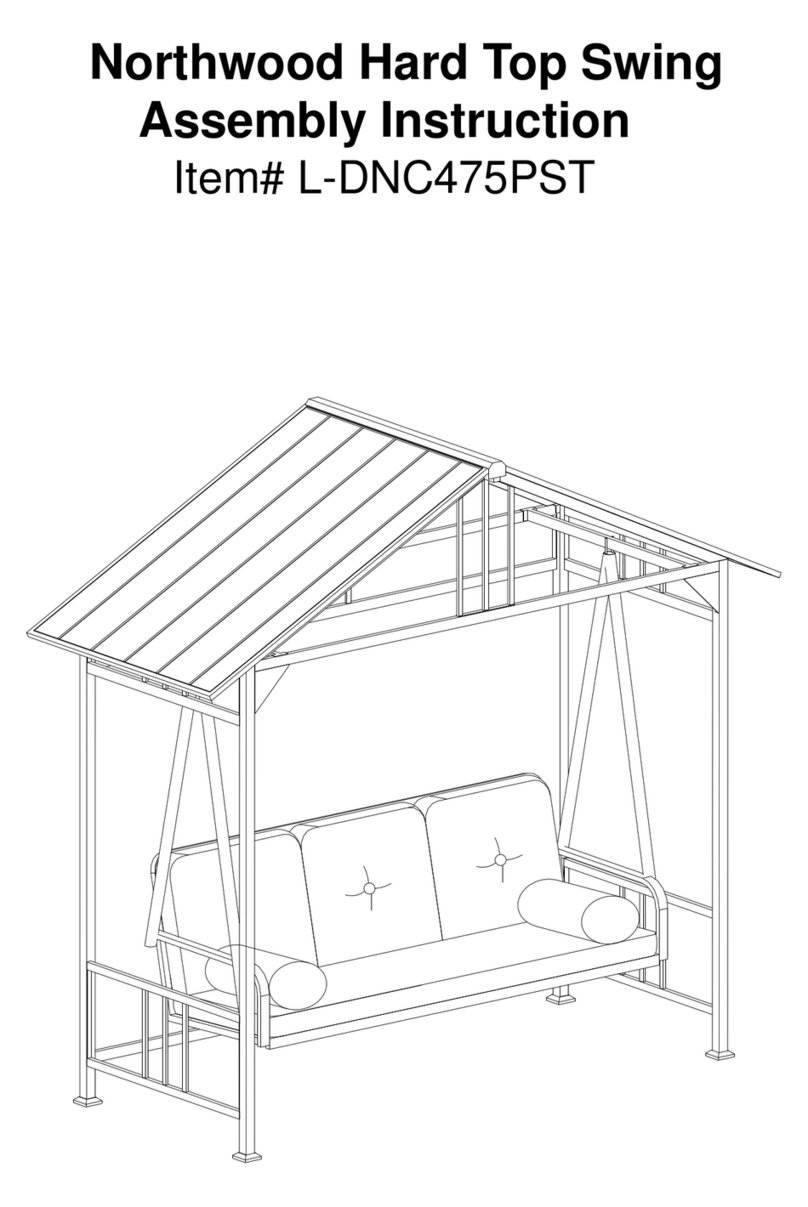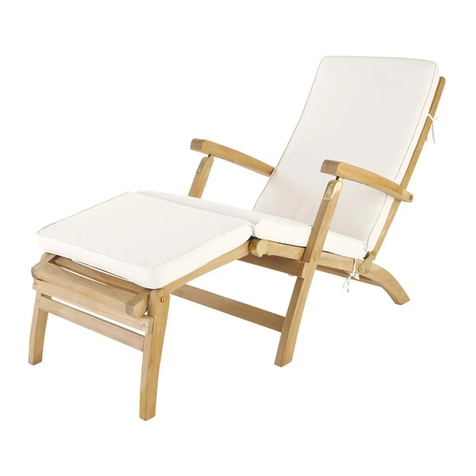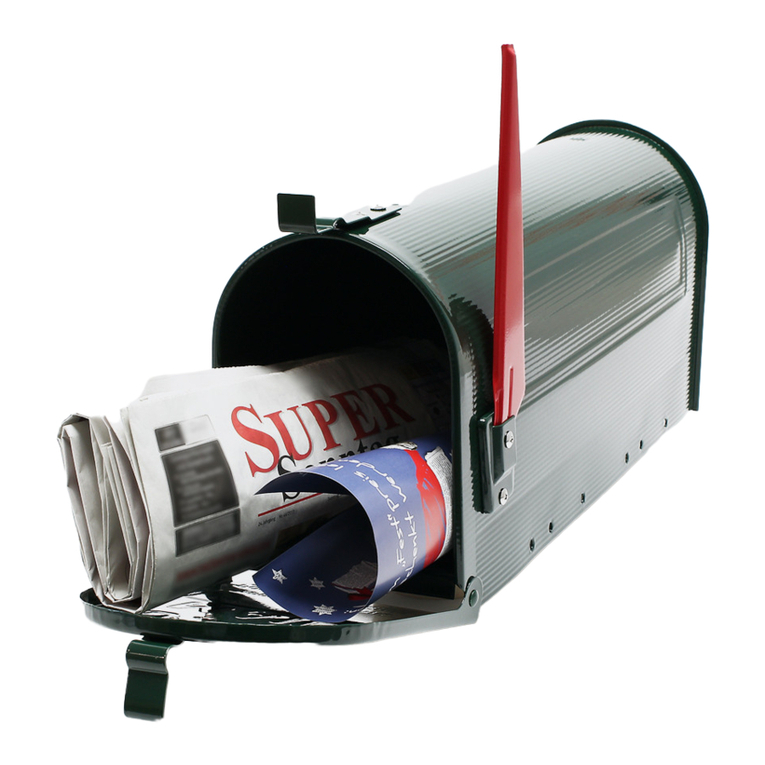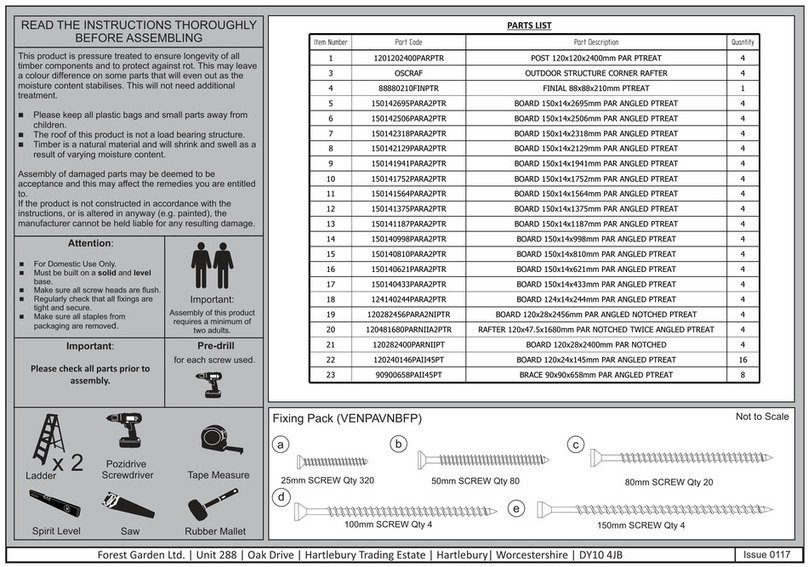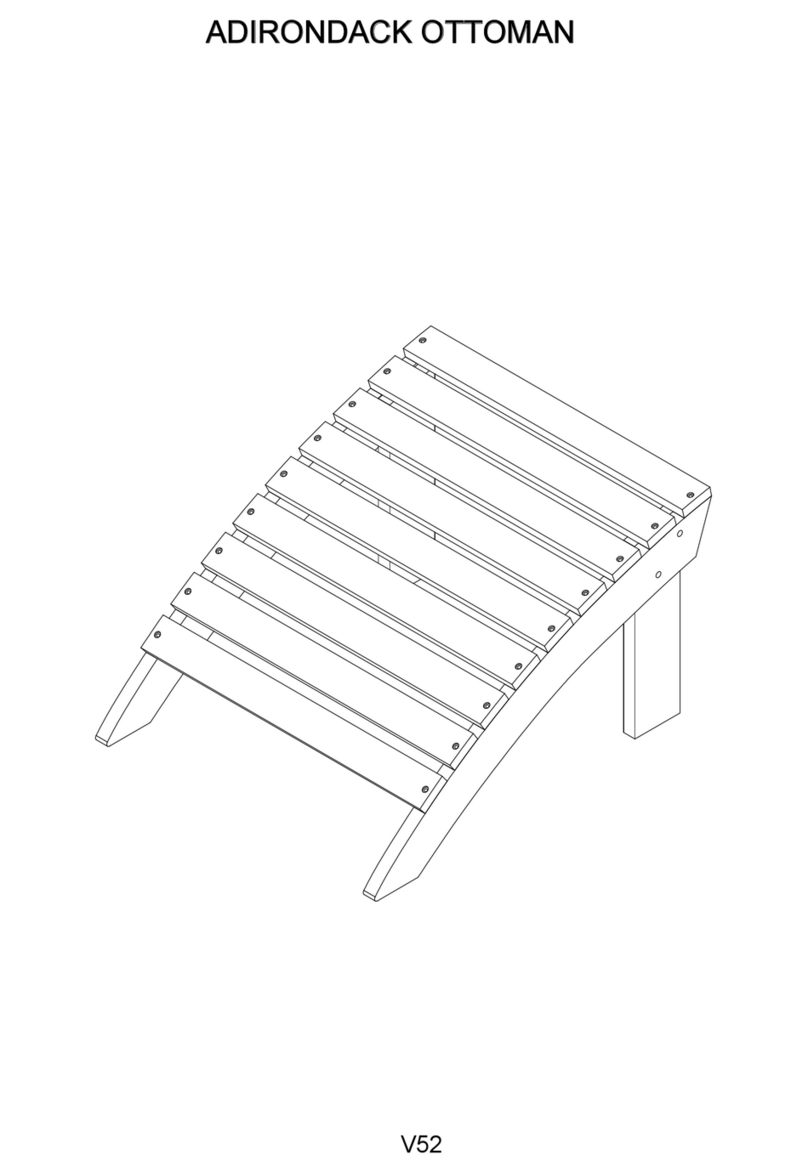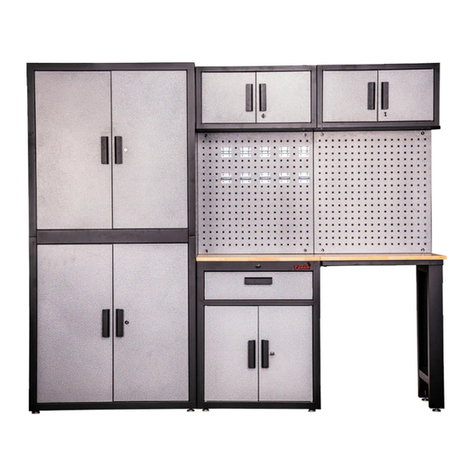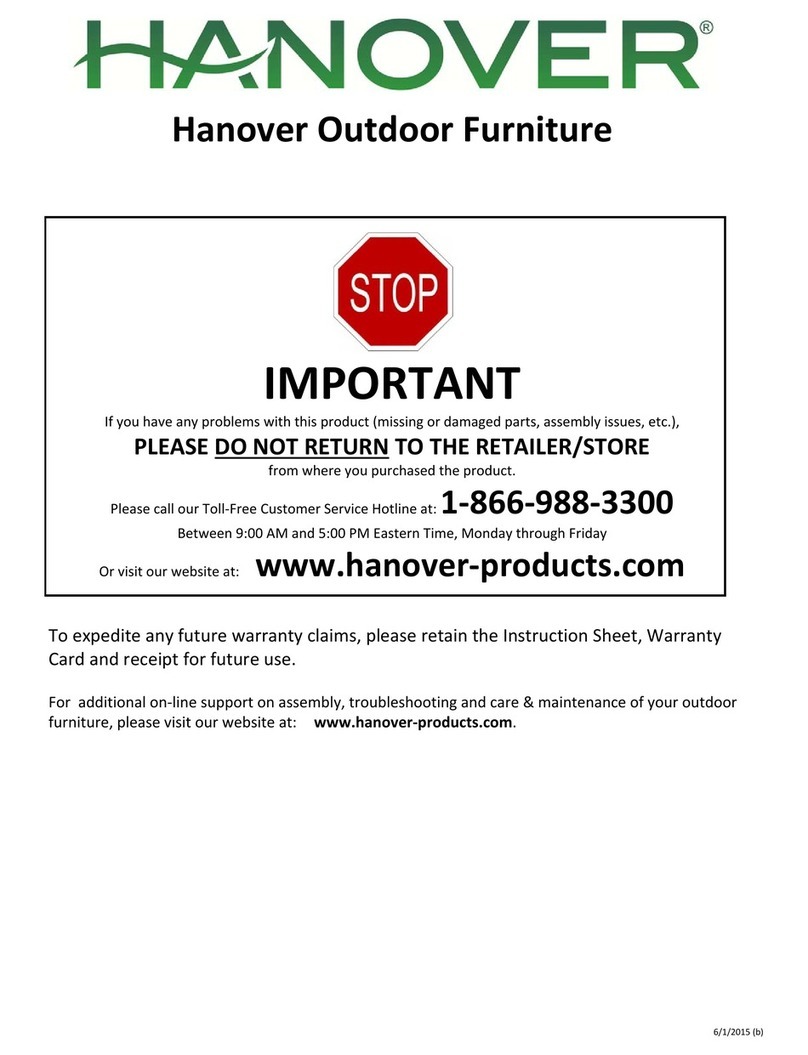ClearSpan 106772 User manual

CLEARSPAN™JOB MASTER BUILDINGS
1
Revision date: 07.23.09
©2009 ClearSpan™
All Rights Reserved. Reproduction is prohibited
without permission.
ClearSpan™Job Master Shop Buildings
18' Wide
STK# DIMENSIONS
106772 18' W x 20' L
106773 18' W x 24' L
106774 18' W x 28' L
106775 18' W x 40' L
106776 18' W x 44' L
Photo may show a different but similar model.

CLEARSPAN™JOB MASTER BUILDINGS
2Revision date: 07.23.09
YOU MUST READ THIS DOCUMENT BEFORE YOU
BEGIN TO ASSEMBLE THE SHELTER.
Thank you for purchasing this ClearSpan™ shelter. When
properly assembled and maintained, this product will
provide years of reliable service. These instructions include
helpful hints and important information needed to safely
assemble and properly maintain the shelter. Please read
these instructions before you begin.
If you have any questions during the assembly, contact
Customer Service for assistance.
SAFETY PRECAUTIONS
• Wear eye protection.
• Wear head protection.
• Wear gloves when handling metal tubes and panels.
• Use a portable GFCI (Ground Fault Circuit Interrupter)
when working with power tools and cords.
• Do not climb on the shelter or framing during or after
construction.
• Do not occupy the shelter during high winds,
tornadoes, or hurricanes.
• Provide adequate ventilation if the structure is
enclosed.
• Do not store hazardous materials in the shelter.
• Provide proper ingress and egress to prevent
entrapment.
ANCHORING INSTRUCTIONS
Prior to assembling this shelter, please read the MUST
READ document included with the shipment.
WARNING: The anchor assembly is an integral part
of the shelter construction. Improper anchoring may
cause shelter instability and failure of the structure.
Failing to anchor the shelter properly will void the
manufacturer’s warranty and may cause serious injury
and damage.
LOCATION
Choosing the proper location is an important step before
you begin to assemble the structure.
The following suggestions and precautions will help you
determine whether your selected location is the best
location.
• Never erect the structure under power lines.
• Identify whether underground cables and pipes are
present before preparing the site or anchoring the
structure.
• Location should be away from structures that could
cause snow to drift on or around the building.
• Do not position the shelter where large loads such as
snow and ice, large tree branches, or other overhead
obstacles could fall.
SITE
After choosing a location, proper preparation of the site is
essential. The following site characteristics will help ensure
the integrity of the structure.
• A level site is required. The site must be level to
properly and safely erect and anchor the structure.
If the site is not level, construct footings to provide
a secure base to assemble the structure. Pre-cast
concrete blocks, pressure-treated wood posts or
boards, or poured footings are all acceptable when
properly used.
• Drainage: Water draining off the structure and from
areas surrounding the site should drain away from the
site to prevent damage to the site, the structure, and
contents of the structure.
WARNING: The individuals assembling this structure
are responsible for designing and furnishing all
temporary bracing, shoring and support needed during
the assembly process. For safety reasons, those who
are not familiar with recognized construction methods
and techniques must seek the help of a qualified
contractor.

CLEARSPAN™JOB MASTER BUILDINGS
3
Revision date: 07.23.09
ASSEMBLY PROCEDURE
Following the instructions as presented will help ensure
the proper assembly of your shelter. Failing to follow these
steps may result in an improperly assembled and anchored
shelter and will void all warranty and protection the owner is
entitled to.
The steps outlining the assembly process are as follows:
1. Verify that all parts are included in the shipment. Notify
Customer Service for questions or concerns.
2. Read these instructions, the Must Read document, and
all additional documentation included with the shipment
before you begin assembling the shelter.
3. Gather the tools, bracing, ladders (and lifts), and
assistance needed to assemble the shelter.
4. Check the weather before you install the roof cover
and any panels (if equipped). Do not install covers or
panels on a windy or stormy day.
5. Re-evaluate the location and site based on the
information and precautions presented in the
documentation included with the shipment.
6. Prepare the site (if this has not been completed).
7. Assemble the frame components in the order they are
presented in these instructions.
8. Assemble the frame including the end walls and struts
(if equipped).
9. Consult the Must Read document for anchoring
comments and instructions.
10. Install the end panels and roof panels (if equipped).
11. Assemble and install the sliding doors.
12. Install and secure the main cover.
13. Read the care and maintenance information at the end
of these instructions.
14. Complete and return all warranty information as
instructed.
LIST OF WORDS AND PHRASES
Before you begin, it is important to become familiar with the
words and phrases used in this instruction manual.
These words and phrases are common to most
ClearSpan™ shelters and identify the different parts of the
shelter. (Some are used in this document. Others may not
apply to this particular shelter.)
• Conduit: An assembly of pipes used to secure the
main cover and end panels (if equipped). Purlins and
some strut assemblies also consist of connected pipes
to form a conduit. Each pipe joint of a conduit assembly
is secured with a self-tapping Tek screw.
• Coupler or Fitting: A part of the frame assembly
where legs, purlins and rafter pipes are inserted and
secured. In most instances, 3-way and 4-way couplers
are used. In some larger applications, couplers are
used to secure the joints of the different rafter sections
during the assembly of the rafters. Some shelters do
not use couplers.
• Foot or Rafter Foot: The part attached to and found
at the base of the rafter or leg of the shelter.
Depending on the shelter, the foot is an optional
purchase. Some shelters do not offer an optional foot.
Some use 1-Way connectors. Others use ground posts.
• Must Read Document: This document includes
building and shelter anchoring instructions, steps for
end wall reinforcement, safety precautions, and notices
and warnings. The Must Read document is sent with all
shelters and buildings. If you did not receive a Must
Read document, contact Customer Service to request
one.
• On-Center: Term used to describe a measurement
taken from the vertical center of the rafter or frame
member to the vertical center of another.
• Purlin: The pipe assembly that runs perpendicular to
the rafters or framework that supports the main cover.
Purlins are found on the sides and roof areas of the
assembled frame, are evenly spaced, and typically run
from the front to the back of the shelter.
• Plain or Straight Pipe: A term used to describe a pipe
that has the same diameter or width throughout its
entire length.
• Strut: A strut is usually a length of pipe with two
flattened ends and is used for diagonal bracing of the
shelter frame. A strut is typically secured to the frame
work by special brackets and bolts.
• Swaged End or Swaged Pipe: The term “swaged''
refers to the tapered end of the pipe or tube. Swaged
ends of a pipe can be inserted into couplers and the
straight ends of other pipes.
• Tek Screw: A self-tapping fastener used to secure pipe
joints and to fasten brackets to rafters.
These terms describe the shipped parts and can also
be found on the materials list/spec sheets included with
the shipment. To aid in the assembly, read through the
following definitions before you begin to assemble your
shelter.

CLEARSPAN™JOB MASTER BUILDINGS
4Revision date: 07.23.09
REQUIRED TOOLS
The following list identifies the main tools needed to
assemble the shelter. Additional tools and supports may be
needed depending on the structure, location, and
application.
• Tape measure or measuring device
• Chalk line (optional)
• Marker to mark locations on the pipes
• Variable speed drill and impact driver (cordless with
extra batteries works best)
• Assorted drill bits
• Metal-cutting tool for pipe and sheet metal panels
• Wrench, ratchet and socket (recommended)
• Hammers and gloves
• Tin snips or similar cutting tool
• Ladders, work platforms, and other machinery for lifting
designed to work safely at the height of the shelter
UNPACK AND IDENTIFY PARTS
The following steps will ensure that you have all the
necessary parts before you begin to assemble the shelter.
1. Unpack the contents of the shipment and place where
you can easily inventory the parts. Refer to the Bill of
Materials/Spec Sheets.
2. Verify that all parts listed on the Bill of Materials/Spec
Sheets are present. If anything is missing or you have
questions, consult the Pictorial Parts Guide and all
shelter diagrams for clarification, or contact Customer
Service.
NOTE: At this time, you do not need to open the plastic
bags containing the fasteners (if used).
QUICK START GUIDE
For a quick overview of this shelter and its components,
consult the Quick Start Guide at the back of these
instructions.
Space below is reserved for customer notes.

CLEARSPAN™JOB MASTER BUILDINGS
5
Revision date: 07.23.09
The following graphics and photos will help you identify the
different parts and show you how they are used.
(Some parts are not shown.)
FA4482B
Tek Screw
104627
4-Way Square Tube
Fitting
104626
3-Way Square Tube
Fitting
100441
Nut Setter
104075
1.75" x 1.75" Square
Tube Insert
102921B
Neo-bonded
Galvanized Washer
104624
1-Way Square Tube
Fitting w/ Plate
105087
Connection Plate
QH1070
Pipe Strap
105088
1-Way Connector
QH1061
Ratchet

CLEARSPAN™JOB MASTER BUILDINGS
6Revision date: 07.23.09
ClearSpan® Job Master Shop
Building (18' Wide) with Outriggers
End Rafter
Inside Rafter
4-Way
Fitting Purlins
Diagonal
Brace
1-Way Square Tube
Fitting w/ Plate
Base Rail
3-Way
Fitting
Base Rail
Purlin
Connection Plate
End Rafter
Inside
Rafter
OVERVIEW
This section is an overview of the process for assembling
your building. See illustration below to identify the main
parts of your Job Master Shop Building.
1. Locate the required parts for each assembly procedure.
2. Assemble and position the main frame base rails and
rafters.
3. Assemble the main frame.
4. Square and anchor the main frame assembly (center
section).
5. Assemble the outrigger base rails and rafters.
6. Assemble and attach outrigger frame assemblies.
7. Anchor the outrigger frame assembly.
8. Install end panels, sheet metal, and
main cover (if equipped) as instructed.

CLEARSPAN™JOB MASTER BUILDINGS
7
Revision date: 07.23.09
ASSEMBLE AND POSITION MAIN FRAME BASE RAILS
NOTE: Assistance is recommended.
Gather the parts:
• Square tubing (See chart below)
• 1.75" x 1.75" square tube insert (#104075)
1-Way square tube fittings (#104624)
• Tek screws and nut setter 3/8'' x 2-9/16" magnetic
The base rails (main center section) consist of 2" x 2"
square tubing and run the length of the building. The tubing
is connected by a 16" square tube (1.75" x 1.75") insert.
Each frame length has a different configuration of 2" x 2"
square tubes. Listed below are the shelter lengths and the
needed tubing for one (1) base rail.
LAY OUT THE BUILDING SITE
After the site is prepared, determine where the building will
be situated and identify the location of the frame corners to
help square the frame after it is assembled.
Taking these steps before assembly saves time and
ensures that the structure is positioned as desired. The
following procedure is a suggested method. Its use
depends on the size of the shelter, shelter use, and the
method used to anchor the shelter.
SQUARE THE SITE
1. Identify a corner where a building rafter or base rail
will be positioned, drive in a stake, and string a line the
exact width of the building and stake in place.
2. Sting a line at least as long as the building from the first
stake at 90°.
NOTE: A transit can be used to ensure an accurate 90°
angle, or the 3-4-5 rule can be used. Refer to diagram.
Using multiples of 3-4-5 such as 6-8-10 or 12-16-20
helps to maintain an accurate 90° angle.
3. After squaring the position of the building and placing
a stake at all corners, string a line between the stakes
to mark the base of the building.
4. Continue with the BASE RAIL ASSEMBLY procedures
that follow.
Shelter Length Tubing Requirement
20' 1 @ 124" & 1 @ 122"
24' 2 @ 124" & 1 @ 46"
28' 2 @ 124" & 1 @ 94"
40' 2 @ 124" & 120" & 118"
44' 4 @ 124" & 1 @ 38"
ASSEMBLE MAIN FRAME BASE RAILS
1. Locate your shelter in the table above and determine
the required tubing for the two main frame base rails.
Example: For a shelter that is 20' long, one base rail
requires one 124" tube and one 122" tube.
2. At each splice, insert the 1.75" x 1.75" square tube 8"
into one of the 2" x 2" tubes and secure with two Tek
screws.
3. Slide the remaining 2" x 2" tube onto the exposed
portion of the insert and secure with Tek screws. See
diagram below.
2" x 2"
Insert
2" x 2"
#104075
1.75" x 1.75" Square tube insert Tek screws
4. Repeat the steps for all base rail splices (if present)
and for the remaining base rail.

CLEARSPAN™JOB MASTER BUILDINGS
8Revision date: 07.23.09
ASSEMBLE AND POSITION MAIN FRAME BASE RAILS
(CONTINUED)
ATTACH 104624 FITTINGS (RAFTER FEET)
Gather the parts:
• Assembled base rails
• 1-Way square tube fittings (#104624)
• Tek screws and magnetic nut setter (3/8'' x 2-9/16")
• Tape measure and marker
NOTE: Before attaching the 104624 fittings, position
the base rail so the heads of the Tek screws face to the
outside, which will be toward the outrigger frame when
these are installed. Do not position the rail with the Tek
screws on the top, bottom, or inside of the rails. Doing so
may interfere with the installation of the #104624 fittings
and metal panels.
1. Using Tek screws, attach the first square tube fitting
(#104624) to the top of the base rail flush with the end
of the base rail as shown.
2. From the center of the installed square tube fitting
(#104624), measure and mark 48" increments along
the length of the base rail. These marks represent the
4' on-center rafter positions.
3. Center a square tube fitting (#104624) on each mark
and secure the fitting to the base rail using Tek screws.
4. Repeat the steps for the remaining base rail.
NOTE: Rafter spacing is measured center-to-center.
5. Position base rails on the site where the shelter will be
assembled. Space rails at the approximate width of the
shelter.
ATTENTION: Do not anchor the rails to the site at this
time.
6. After the base rails are assembled, continue with the
MAIN FRAME RAFTER ASSEMBLY.
48"
center-to-center
#104624
Square Tube
Fitting
Center of the fitting
Tek screws
MAIN FRAME RAFTER ASSEMBLY
Gather the parts:
• Rafter pipe ( #12CP20P1)
• Rafter pipe (#18CP20P3)
• Rafter pipe (#S20P036 & #S20P048)
• 3-Way Square tube fittings (#104626)
• 4-Way Square tube fittings (#104627)
• Tek screws and magnetic nut setter (3/8'' x 2-9/16")
Main Frame Rafter Assembly Procedure
Each rafter assembly consists of seven (7) rafter tubes: one
(1) curved center pipe (for the top or peak), two (2) bent leg
pipes, two (2) straight pipes between the peak and the bent
leg pipes, and two (2) straight pipes.
NOTE: The different end rafter tubes are connected using
3-Way tube fittings (upper rafter) and square tube insert
(#104075) for the rafter legs (lower).
Interior or mid rafters use 4-Way tube fittings in place of
the 3-Way tube fittings used for the end rafters.
#18CP20P3
#12CP20P1
#S20P036
#S20P048

CLEARSPAN™JOB MASTER BUILDINGS
9
Revision date: 07.23.09
MAIN FRAME RAFTER ASSEMBLY (CONTINUED)
MAIN FRAME END RAFTERS
Complete the following steps to assemble the two (2) end
rafters for the main frame.
NOTE: The two (2) end rafters are assembled using 3-Way
square tube fittings (#104626) positioned between the
upper tube splices.
1. Select the tubes needed to assemble the rafter and
place these on the ground as shown on previous page.
NOTE: The lower leg pipes (#S20P036) are 36" long.
The upper (#S20P048) pipes are 48" long. Measure the
pipes if needed to install them in the correct location.
DO NOT USE THE 46" (S20P046) SQUARE TUBES;
THEY ARE RESERVED FOR THE PURLINS OF THE
MAIN FRAME.
2. Insert the 3-Way square tube fittings (#104626) into the
rafter pipes as shown below and secure them using Tek
screws.
The free end of each 3-Way square tube fitting
(#104626) must face the same direction. The free
section of the tube fitting is used to connect the purlin
pipes. With the rafter on the ground, the free end of the
fitting will point straight up.
IMPORTANT: To prevent damage to the main cover,
position the Tek screws so the heads do not contact the
main cover when it is installed.
3. Connect the lower rafter legs using the 1.75" x 1.75"
square tube insert (#104075). (See the Base Rail
assembly steps if needed.) Place the insert 8" into the
rafter pipes and secure using Tek screws.
4. Repeat Steps 1–3 for the remaining end rafter.
NOTE: There are only two (2) end rafter assemblies.
MAIN FRAME INTERIOR RAFTERS
1. Select the tubing for the first interior rafter assembly
and position it on the ground as previously described
for the end rafters.
2. Install a 4-Way square tube fitting (#104627) in the
locations shown in the diagram below and secure the
joints using Tek screws.
With the rafter on the ground, one free end of each
4-Way tube fitting will point up; the other free end will
point toward the ground.
IMPORTANT: To prevent damage to the main cover,
install Tek screws so the heads do not contact the main
cover when it is installed.
3. Repeat the steps for all remaining interior rafters.
4. Once all rafter assemblies are complete, continue with
the MAIN FRAME ASSEMBLY instructions that follow.

CLEARSPAN™JOB MASTER BUILDINGS
10 Revision date: 07.23.09
MAIN FRAME ASSEMBLY
The following instructions assume the rafter feet are
properly spaced on each base rail.
ATTENTION: If the site is not level as recommended, you
must take the necessary steps to level the site. The frame
will not assemble properly without a level side.
Gather the parts:
• Rafter assemblies and assembled base rails
• Square tubes (#S20P046) for purlins
• Tek screws and magnetic nut setter (3/8'' x 2-9/16")
1. Carefully stand the first end rafter and place the leg
pipes on the first set of fittings on the base rails.
2. Anchor the first rafter with ropes or other temporary
bracing. Verify that the rafter is plumb (straight).
NOTE: In the above diagram, ropes (identified by black
lines for clarity) are used to temporarily anchor the
rafter in place. Frame shown may differ from actual
frame. With the rafter standing, the free end of each
3-Way fitting must point to the inside of the frame.
For this first end rafter, all temporary bracing must
remain in place until other rafters are set and attached
to the first rafter and each other.
3. Secure the rafter leg tubes to each 104624 fitting using
a Tek screw. Install screws in line with the base rail as
shown below.
4. Carefully stand the first interior rafter and place the leg
pipes on the next set of 104624 fittings.
5. Secure the rafter leg tubes to the fittings using Tek
screws as previously described.
6. Place a 46" square tube (#S20P046) on one of the
3-Way fittings of the end rafter and secure with a Tek
screw.
7. Place the free end of the purlin onto the 4-Way fitting of
the second rafter, which is the first interior, and steady
the rafter.
8. With assistance, slide the remaining purlin tubes on to
the fittings of each rafter.
9. With all purlin tubes in position, measure 48" from the
center of the end rafter to the center of the interior
rafter. Adjust the rafter forward or backward as needed
to achieve the 48" on-center dimension.
10. With the rafters plumb and properly spaced, secure the
purlin tubes to the fittings.
11. Continue to stand, place, and secure the remaining
rafters to the base rails to complete the assembly of the
frame.
12. Once all rafters are set and all purlins are in place
and secured to the 3-Way and 4-Way fittings, remove
the temporary bracing (if needed), and square the
assembled frame.
Frame shown may differ from actual frame. It is used for
illustration only.
Tek screw

CLEARSPAN™JOB MASTER BUILDINGS
11
Revision date: 07.23.09
SQUARE THE ASSEMBLED MAIN FRAME
Complete these steps:
1. Perform a final square of the main frame by measuring
diagonally (corner-to-corner) at the base and verify that
the two measurements are equal.
2. Examine the frame and remove any sharp edges from
the frame and reposition screws so they do contact the
main cover or metal panels when these are installed.
3. Verity that all pipe and tube joints are secured with Tek
screws. This includes base rails, rafters, purlins, and all
additional bracing.
4. After the frame is squared, read or reread the MUST
READ document and anchor the frame in place.
FRAME TOP VIEW
ANCHOR THE SHELTER
At this point in the assembly process, anchor the
assembled frame. Once the frame assembly is anchored
properly, continue with these instructions.
WARNING: Securing the base rails to concrete blocks
or wood boards set on the site is not a substitute for
properly anchoring the shelter. You must anchor the
shelter as described in the MUST READ document.
FAILING TO PROPERLY ANCHOR THE SHELTER
WILL RESULT IN DAMAGE TO THE SHELTER AND
MAY CAUSE PERSONAL INJURY.
READ THE MUST READ DOCUMENT TO PROPERLY
ANCHOR THE SHELTER.
Install the anchor kits if used in a position that will not
interfere with the installation of the metal panels on the
inside of the main, center frame, or the exterior metal
panels of the outrigger frame when these are installed.
The diagrams below illustrate two possible ways to properly
anchor the shelter to the site.
The parts shown in the diagrams regarding anchor systems
are not included with the shelter.
Contact Customer Service at 1-800-245-9881 to purchase
additional parts to anchor the shelter (if needed).
Anchor System for use on concrete
Ground Anchor System

CLEARSPAN™JOB MASTER BUILDINGS
12 Revision date: 07.23.09
ASSEMBLE OUTRIGGER RAFTERS
Each outrigger rafter consists of two (2) large 2" x 3"
rectangular pipes and a pipe strap.
Gather the parts:
• Rafter pipe ( #R23S075)
• Rafter pipe (#07CPR23P1)
• Pipe strap (#QH1070)
• Tek screws and magnetic nut setter (3/8'' x 2-9/16")
The following steps describe one way to assemble the
individual rafters. Consult the Front Profile rafter diagram in
the Quick Start section to view an assembled rafter.
1. Position the 2" x 3" rectangular tubes as shown.
2. Insert the swaged end of the curved pipe into the
plain end of the straight pipe to assemble the rafter as
shown.
Typical Outrigger Rafter Assembly
#R23S075
#07CPR23P1
3. After connecting the separate pipes, locate one (1) pipe
strap (#QH1070) and install as shown.
ATTENTION: The pipe strap is installed on the
underside of the rafter with one Tek screw on each side
of the pipe splice as shown.
4. Install two additional Tek screws at each pipe joint in
the location identified above.
NOTE: DO NOT TIGHTEN THE PIPE STRAP AT THIS
TIME. The pipe strap will be tightened after the purlin is
installed.
5. Repeat the procedures to assemble the remaining
rafters.
6. After all rafters are assembled, assemble the outrigger
base rail assemblies.
Tek screws

CLEARSPAN™JOB MASTER BUILDINGS
13
Revision date: 07.23.09
ASSEMBLE OUTRIGGER BASE RAILS
This procedure describes one way to assemble the
outrigger base rail and to attach the heavy-duty 1-Way
connectors, used to secure the rafter legs, to the base rail.
Gather the parts:
• Square tubing (See chart below.)
• Tek screws and magnetic nut setter (3/8'' x 2-9/16")
The base rails consist of 2" x 3" square tubing (plain and
swaged) and run the length of the building. Each shelter
length has a different configuration of 2" x 3" square tubes
for the outrigger base rails. The tubing requirements for
each base rail for the different building lengths are listed
below. (S = Swaged, P = Plain)
Shelter Length Tubing Requirement (per base rail)
20' 1 @ 123" & 1 @ 126"
24' 2 @ 123" & 1 @ 54"
28' 2 @ 123" & 1 @ 102"
40' 3 @ 123" & 1 @ 126"
44' 4 @ 123" & 1 @ 54"
ASSEMBLE BASE RAILS
1. Locate the shelter in the table above and determine the
required tubing for the two base rails.
Example: For a shelter that is 20' long, one base rail
requires one (1) 123" swaged tube (R23S123) and one
(1) 126" plain tube (R23P126).
2. Insert the swaged end of each tube into the plain end
of a tube until the base rail is assembled.
NOTE: Use a hammer and wood block to lightly tap
and seat the tubes together if needed.
3. Repeat the procedure as needed for the remaining
base rail.
4. Install one Tek screw at each splice on one side of the
rail to secure the two tubes. DO NOT install the Tek
screws on the top, bottom, or outside surface (where
the metal panels will be attached) of the outrigger base
rails.
ATTACH 105088 1-WAY CONNECTOR (RAFTER FEET)
Gather the parts:
• Assembled base rails
• 1-Way connector (#105088)
• Tek screws and magnetic nut setter (3/8'' x 2-9/16")
• Tape measure and marker
NOTE: Before attaching the 105088 connectors, verify
that Tek screws are not installed on the top or bottom
of the outrigger base rail. Installing Tek screws in these
locations may interfere with the installation of the #105088
connectors for the rafters. (Move screws if needed.)
1. Using Tek screws, attach the first square tube fitting
(#105088) to the top of the base rail flush with the end
of the base rail as shown.
2. From the center of the installed square tube fitting
(#105088), measure and mark 48" increments along
the length of the base rail. These marks represent the
48" on-center rafter positions.
3. Center a square tube fitting (#105088) on each mark
and secure the fitting to the rail using Tek screws.
4. Repeat the steps for the remaining base rail.
NOTE: Rafter spacing is measured center-to-center.
5. After the base rails are assembled, continue with the
OUTRIGGER FRAME ASSEMBLY.
48"
center-to-center
Tek screw
Top of Base (3" wide)
#105088
Square Tube
Fitting
Center of the fitting
Tek screws

CLEARSPAN™JOB MASTER BUILDINGS
14 Revision date: 07.23.09
OUTRIGGER FRAME ASSEMBLY
At this point, all outrigger rafters are assembled and all
1-Way connectors are attached to the assembled outrigger
base rails.
SITE COMMENT: For proper assembly of the frame, a level
site is required for the base rail.
SETTING OUTRIGGER RAFTERS
WARNING: Rafters can be heavy and awkward to
handle. Use caution and adequate assistance when
setting the rafters in position.
Gather the parts:
• Outrigger rafter and base rail assemblies
• 1.315" pipe for purlin
• Connection plates (#105087)
• Tek screws and nut setter (3/8'' x 2-9/16 magnetic)
The following steps describe one way to assemble the
outrigger frame.
1. Position the base rail parallel with the main frame
assembly.
2. Lift one rafter into position and set the leg on the first
1-Way connector at one end of the base rail.
Move the base rail as needed so the upper end of the
rafter rests against the rafter leg of the main (or center)
frame assembly. Brace the first rafter in place so that it
will not fall or move.
WARNING: TO PREVENT DAMAGE OR INJURY, DO
NOT LEAVE THE RAFTER UNATTENDED.
3. Secure the rafter leg to the 1-Way connector on the
outrigger base rail using two Tek screws. See the
diagram below.
ATTENTION: Install Tek screws through the rafter
leg and into the 105088 connector. Tek screws must
secure the rafter to the 105088 connector. See the
diagram under Step 1 on the previous page.
NOTE: Do not install
screws on the side of the
rafter leg where the metal
panels will be attached
later in these instructions.
Verify that the Tek screws
are secured to one of the
three sides of the 105088
connector.
4. With the first rafter secured to the outrigger base rail,
realign the base rail and rafter with those of the main
frame as needed and locate two (2) connection plates
(#105087).
5. Position the first connection plate (1) on the assembled
rafter as shown and secure it using Tek screws.
6. After attaching the first plate, attach the second
connection plate (2) to the remaining side of the rafter.
7. After anchoring the first rafter to the main frame
assembly, set the second rafter in place and secure
the upper end to the rafter leg of the main frame as
described in Steps 4-6 above.
8. Take one, swaged section of pipe (#131S075) used for
the purlin and slide it through the pipe straps on the two
rafters as shown below. Loosen straps if needed.
Connection
Plate (1)
Top of
Outrigger
Rafter
Main Frame
Rafter
Connection
Plate (2)
Purlin Pipe
The main frame
diagonal rafter
brace is installed
after the outrigger
frames are
assembled and
attached to the
main frame.

CLEARSPAN™JOB MASTER BUILDINGS
15
Revision date: 07.23.09
OUTRIGGER FRAME ASSEMBLY (CONTINUED)
9. Secure the second rafter to the 1-Way connector on
the outrigger base rail and adjust the rafter width as
needed to achieve the 48" on-center dimension.
NOTE: The end of the purlin at the end rafter extends
about 1/2" through the pipe strap as shown below.
To prevent conflicts with the installation of the end wall
metal panels, do not allow the purlin pipe to extend
beyond the edge of the rafter.
Diagram A (above) shows pipe strap and purlin at the
first rafter. Diagram B (below) shows the purlin at the
second (or inside) rafter. (Pulin position may vary.)
10. With the purlin in position, secure the pipe strap to the
first rafter and install a Tek screw through the pipe strap
and into the purlin. See Diagram A.
11. Verify that the rafter spacing is 48" on-center, tighten
the pipe strap on the second rafter, and install a Tek
screw through the pipe strap to secure the purlin in the
strap.
12. Repeat the above steps as needed to attach the
remaining outrigger rafters to the main frame and to
complete the installation of the purlin for the first side.
Tek screw
Tek screw
NOTE: End the purlin run with the shorter, plain pipe
(131P0XX), where the XX represents the length
needed to reach the end of the frame. This pipe does
not have a swaged/tapered end. If the end rafter is
plumb and the purlin extends beyond the pipe strap
when installed, cut the purlin pipe as needed to keep it
from extending past the end rafter.
Typically purlin pipe does not need to be cut. Verify that
you have selected the correct pipe before cutting a pipe
to length.
13. Return to each pipe strap and verify that all Tek screws
are tight and that a Tek screw has been installed to
secure the purlin to the pipe strap.
14. Return to each purlin pipe splice and secure the splice
with a Tek screw as shown below.
ATTENTION: All pipe splices are secured with Tek
screws.
15. Verify that all Tek screws are installed and tight and
that all fasteners used to secure the frame to the main
frame assembly are properly installed and tight.
16. After the assembly and installation of the first outrigger
frame is complete, repeat the steps to assemble and
install the remaining outrigger frame.
17. Continue by installing the diagonal braces for the main
frame rafters as described in the following procedure.
Diagram A
End Rafter
Diagram B
Inside
Rafter

CLEARSPAN™JOB MASTER BUILDINGS
16 Revision date: 07.23.09
READ THE MUST READ DOCUMENT TO PROPERLY
ANCHOR THE SHELTER.
The diagrams below illustrate two possible ways to properly
anchor the shelter to the site.
The parts shown in the diagrams regarding anchor systems
are not included with the shelter. Contact Customer Service
at 1-800-245-9881 to purchase additional parts to anchor
the frame. Install anchor kits in a location that will not
interfere with the installation of the metal panels.
Anchor System for use on concrete
Ground Anchor System
ANCHOR THE SHELTER
At this point in the assembly process, anchor the outrigger
frames. Once the frame assembly is anchored properly,
continue with these instructions.
WARNING: Securing the base rails to concrete blocks
or wood boards set on the site is not a substitute for
properly anchoring the shelter. You must anchor the
shelter as described in the MUST READ document.
FAILING TO PROPERLY ANCHOR THE SHELTER
WILL RESULT IN DAMAGE TO THE SHELTER AND
MAY CAUSE PERSONAL INJURY.
INSTALL MAIN FRAME BRACING
Complete these steps to install the diagonal bracing for the
main frame.
Gather the parts: Bracing (#105089) and Tek screws
1. Locate one (1) three-foot (3') brace and place it into
position as shown below.
NOTE: Position the brace so the lower end is aligned
with the top of the connection plates as shown above.
2. Secure the brace to the rafter using Tek screws as
shown above.
3. Repeat the steps to install the remaining braces.
NOTE: Keep the angle of all diagonal bracing
consistent throughout the frame during installation. The
metal panels (when installed) end at the point where
the lower end of each diagonal brace is attached to the
rafter leg.
4. After all diagonal bracing is installed and secured to
the assembled frame, anchor the outrigger frame as
described in the MUST READ documentation.
ATTENTION: The
frame tubes shown
in these diagrams
may differ from the
actual frame. They are
used for illustration
purposes only.
Tek screws
Tek screws
End rafter showing
the location of the
diagonal brace.
Install brace so the
lower end is flush
with the top of the
connection plates. Connection
Plate

CLEARSPAN™JOB MASTER BUILDINGS
17
Revision date: 07.23.09
OPTIONAL END PANEL INSTALLATION
These instructions describe installing the optional end
panels if equipped. If you want to purchase end panels for
the main, center frame of your Job Master Shop building,
visit us at www.ClearSpan.com, or contact your sales
representative. For a building without end panels, skip to
and continue with the installation of the end wall framing for
the outrigger frame.
WARNING: To prevent property damage and possible
injury, do not attempt to install the end panels or main
cover on a windy or stormy day.
Required parts: End panel (or panels), Tek screws, and
neo-bonded washers.
Each end panel is designed to wrap around the end rafter
at the end of the main, center frame. Panels are then
stretched and secured to the end rafters using Tek screws
and neo-bonded washers spaced 24" apart.
NOTE: End panels are typically shipped as untrimmed
rectangular panels. After securing the panel to the frame,
the excess material can be trimmed as desired.
Complete the following steps to install the optional end
panel or panels.
1. Locate the end panel and spread it out on the ground
at the desired end of the main frame.
2. Center the panel in the end wall opening so the zippers
are in the desired position. Middle zipper is centered on
the end wall.
NOTE: Verify that the outside of the panel is down or
toward the ground. The top of the panel is positioned
away from the frame.
3. With assistance, lift the panel up and against the end
rafter of the frame. Use additional help and the proper
lifts to safely lift the end panel into position.
4. While the panel is held in position, stretch the panel
from side-to-side at ground level.
5. Wrap the panel around the bottom of each leg of the
end rafter and secure it to the inside (or backside) of
the rafter leg using a Tek screw and washer.
NOTE: Keep the end panel at or near ground level as
desired during this step.
6. Working from the bottom toward the top, continue
wrapping the end panel around each leg of the end
rafter and securing it to the back of the end rafter.
ATTENTION: To prevent damage to the main cover
when it is installed, position all Tek screws on the
backside of the rafter. The main cover will overlap the
end rafter to finish the edge when installed.
To minimize wrinkles, keep the panel stretched evenly
as it is attached to the frame. It may be necessary to
remove and reinstall Tek screws and washers during
the process for best results and fewer panel wrinkles.
The frame shown in the following diagrams may differ from
the actual frame. The installation of the end panel is the
same for all frames within this building line.
End Panel for Center Frame
Section
Top
To prevent zipper
damage, do not stretch
the panel too tight.
To prevent
zipper damage,
do not stretch
the panel too
tight.

CLEARSPAN™JOB MASTER BUILDINGS
18 Revision date: 07.23.09
OPTIONAL END PANEL INSTALLATION (CONTINUED)
7. Once the end panel is secured to the end rafter, return
to the areas identified by the arrows in the diagram
below.
8. Trim the panel as needed so it will not interfere with
the installation of the metal panels for the roof of each
outrigger frame.
NOTE: The end panel must lay flat against the frame
at the point where the outrigger rafter is secured to
the end rafter of the main, center frame. This will allow
proper installation of the metal roof and end panels
of the outrigger frame. The metal end panels of the
outrigger end walls will overlap the main frame end
panel when they are installed.
9. After the end panel is installed, repeat the steps to
install the end panel for the remaining end of the
building if equipped.
10. With the end panels installed, continue with the
installation of the end wall framing for the outrigger
frames.
NOTE: The excess end panel material that extends
past where the panel is attached to the end rafter can
be trimmed as desired or it can remain in place.
Space below is reserved for customer notes.

CLEARSPAN™JOB MASTER BUILDINGS
19
Revision date: 07.23.09
INSTALL END FRAMING FOR OUTRIGGER FRAMES
With the frame properly anchored, install the end wall frame
for the outriggers. All end walls are framed the same.
Required parts:
• 2" x 2" Square Tubing (105328)
• 105087 Connection Plates
• 105088 1-Way Connectors
The steps below describe how to assemble the end wall
frame for all outrigger end walls.
1. Move to one end of an outrigger frame and measure
the distance between the base rail of the main frame
and the base rail of the outrigger.
2. Take one 2" x 2" square tube (#105328) and cut the
tube 1/4" shorter than the length determined in Step 1.
NOTE: The 1/4" accounts for the 1-Way connectors
that are inserted into the tube and used to secure the
base rail to the frame of the building.
3. After cutting the tube to the required length, insert a
1-Way connector into each end (as shown) and secure
the base rail to the frame.
4. On the back (or inside) surface of the base rail, install
a Tek screw through the base rail and into the 1-Way
connector at each end to secure the connector to the
tube.
5. Repeat the steps to cut and install the base rail for the
remaining three ends of the outrigger frames.
6. Once all base rails are installed, complete the next
procedure to frame an opening for the sliding doors.
FRAME THE OPENING FOR THE SLIDING DOORS
The rough door dimensions shown in the diagram to the
left are measured inside-to-inside. Complete the following
steps to complete the end wall framing.
1. Take a 2" x 2" tube (#105328) and cut it to 72" for the
vertical door frame tube.
NOTE: The tube is 1/4" shorter to account for the
1-Way connectors that are inserted and secured to
each end of the tube.
2. Insert a 1-Way connector into each end and secure
each connector to the tube using a Tek screw. Set the
assembled tube aside.
3. Measure 46 1/2" along the end wall base rail and mark
the location on the front edge of the base rail. This
mark identifies the inside edge of the vertical door
frame tube. See the diagram to the left.
4. Take the vertical tube, align the inside edge of the tube
with the mark on the base rail (Step 3), and secure
the vertical tube to the base rail using Tek screws. The
inner flange of the 1-Way connector will extend to the
inside of the door frame. The measurement from the
main frame rafter leg to the vertical door frame tube of
the end wall will be 46 1/2".
5. Measure the header length needed and prepare
another 2" x 2" tube. Attach one end of the header tube
to the end rafter leg of the main frame using a 1-Way
connector as previously described.
1-Way Connector
6. Secure the outer end of the header to the outrigger end
rafter using two (2) plates (#105087) as shown above.
7. Repeat the steps to install the end wall frame for the
remaining end walls and continue by installing the stay
rollers for each sliding door.
Photo shows the
header connected
to the outrigger
end rafter. Install a
105087 plate on both
sides to secure the
header.
Header
End Rafter
Step 1
Height
72 1/4"
Width
46 1/2"
1-Way Connector
Vertical Door
Frame Tube
Header
Base Rail
Base Rail

CLEARSPAN™JOB MASTER BUILDINGS
20 Revision date: 07.23.09
INSTALL STAY ROLLERS FOR SLIDING DOORS
The stay rollers for each sliding door are designed to
guide the door when it is opened and closed. One roller is
installed for each sliding door.
Required parts and tools:
• Stay rollers
• 1/8" drill bite and drill
• Hammer and center punch
• Philips® screwdriver
Complete the steps below to install the stay rollers for the
sliding doors.
1. Locate the stay roller and remove the roller from the
mounting bracket.
2. Measure 1-1/2" up from the bottom of the end wall
base rail and mark the location on the base rail.
3. Center the mounting bracket on the vertical door frame
member, align the bottom of the bracket with the line
marked on the base rail, and mark the mounting screw
holes using the bracket as a template. See the previous
diagram for clarification.
4. Center punch the holes and drill each hole using a drill
and 1/8" drill bit.
5. Secure the angled mounting bracket to the frame
member using the screws supplied with the stay roller
assembly.
6. With the bracket secured in place, reassemble the stay
roller as shown in the diagram to the left.
NOTE: Do not tighten the roller bolt at this time. It is
adjusted and tightened when the door is installed.
7. After installing the first stay roller, move to the end
of the frame where the remaining sliding door will be
located and install a stay roller in that location.
8. Once the stay rollers are installed, anchor the base rail
of each end wall to the site (if desired).
9. Verify that all frame anchors are installed (additional
purchase required) and tight. (Contact customer
service to purchase additional ground anchor kits if
needed.)
10. Prepare and attach the metal panels to the outrigger
frames.
Classic Rib
Anti-Siphon Groo
ve
PANEL INSTALLATION DETAILS
ATTENTION: Panel ribs differ. Always overlap the
individual panels as shown. The rib with the anti-siphon
groove is installed under the classic rib.
PANEL DIAGRAM
1-1/2"
Fully Assembled
Door (Door
is assembled
later in these
instructions.)
Vertical
Door
Frame
Base Rail
End View of Sliding Door and Stay Roller
Stay Roller Assembly
End Wall
Base Rail
Vertical
Door Frame
Member
Align bottom
of mounting
bracket with
the mark on the
base rail.
Vertical
Door Frame
Member
This manual suits for next models
4
Table of contents
Other ClearSpan Outdoor Furnishing manuals
Popular Outdoor Furnishing manuals by other brands

Ballard Designs
Ballard Designs JC334 Assembly instructions
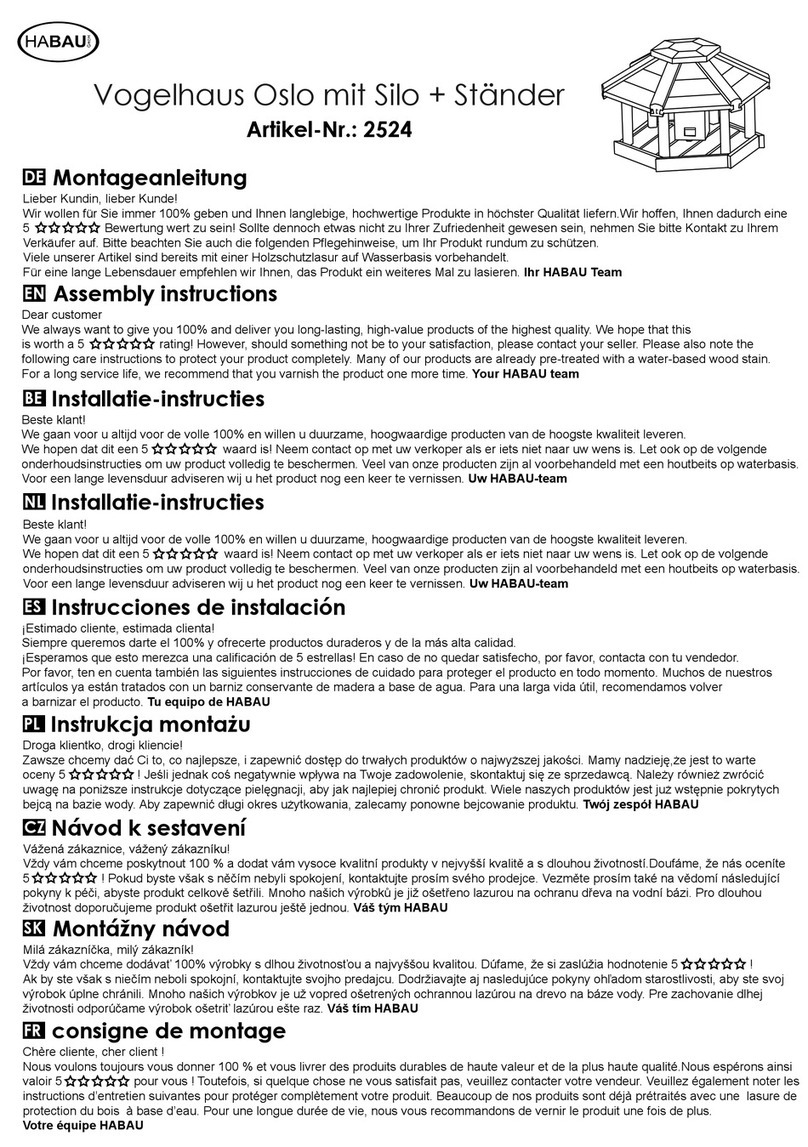
HABAU
HABAU Vogelhaus Oslo mit Silo + Stander Assembly instructions
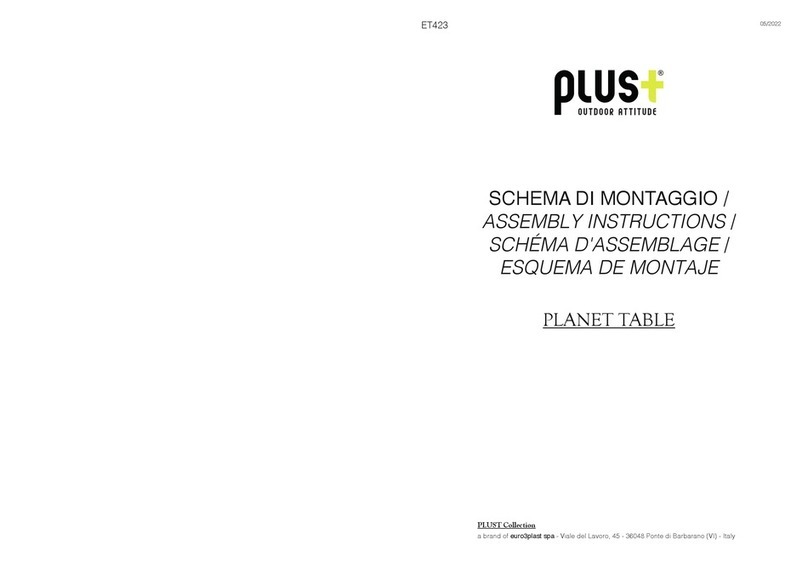
Plust
Plust Planet Table Assembly instructions

Grange Fencing
Grange Fencing Elite Arch Assembly instructions
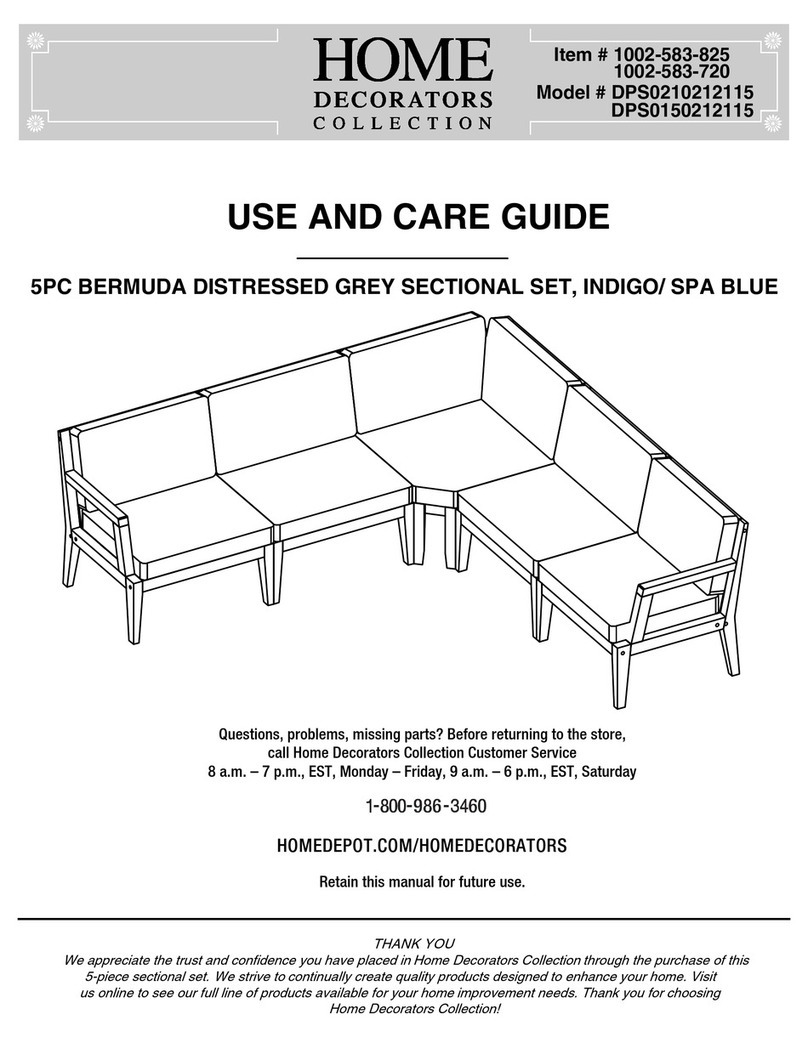
Home Decorators Collection
Home Decorators Collection BERMUDA DPS0210212115 Use and care guide

Coolaroo
Coolaroo FAIRHAVEN Assembly guide
